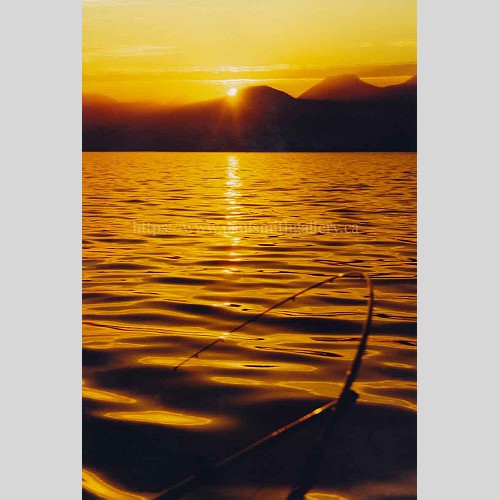Evening Bite
One evening while fishing in Nootka Sound with a couple of guests after the bite had subsided, we were blessed with an extraordinairy example of sunlight reflecting across the ocean from the sun setting behind the mountains of Nootka Island. As the sun dipped further behind the mountains the light became much warmer and golden. I decided to bring out my Sony DSC H9 camera and take a series of images that documented the changing light as it sank beneath the horizon.
Because the water was relatively calm, I decide to slow down my shutter speed to capture the colors more dramatically than if I used a faster shutter speed. I set the shutter to 1/60 sec and the aperture to f8 and began to shoot pictures in sequence every two minutes. I used the gunnel of my boat when I could to steady my camera to mitigate the shake from the water movement and of my guests walking around the boat. I also tried using 1/125 second shutter speed for a couple of shots and made notes so I could compare the two later on. My guests also brought out their camera gear and asked me questions regarding the settings they should be using and why I was doing what I was doing. I explained my reasons for trying to document the light changes so I could understand how light is refracted differently at different times and levels on the horizon.
At one point during my experiment I caught a glimpse of my fishing rod still in the rod holder and the sun reflection across the water lining up with the tip of the rod and decided to change from shooting horizontally to vertically to try and capture the fishing rod and part of the boat in the composition. I took a couple of shots and went back to shooting my documentary. As you can see this one became the photo that everyone seems to want hanging on their wall.
I have used my experiment of images to better understand how the colors are affected as the sun sets lower in the sky over time. Even when shooting pictures now of similar situations where the sun is setting behind an object I draw from this experiment to use the knowledge gained from taking over twenty photographs that wonderful evening. Although some of them look indifferent from the ones before, if you look closely at the color of light and how much warmer it becomes the lower the sun sets behind the mountains you begin to understand the correlation between the angle and time.


